
An inflorescence is a group or cluster of flowers arranged on a stem that is composed of a main branch or a complicated arrangement of branches. Morphologically, it is the modified part of the shoot of seed plants where flowers are formed on the axis of a plant. The modifications can involve the length and the nature of the internodes and the phyllotaxis, as well as variations in the proportions, compressions, swellings, adnations, connations and reduction of main and secondary axes. One can also define an inflorescence as the reproductive portion of a plant that bears a cluster of flowers in a specific pattern.
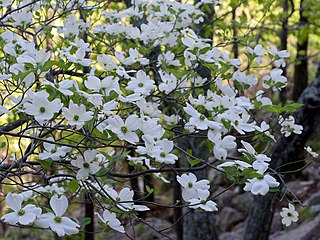
Cornus florida, the flowering dogwood, is a species of flowering tree in the family Cornaceae native to eastern North America and northern Mexico. An endemic population once spanned from southernmost coastal Maine south to northern Florida and west to the Mississippi River. The tree is commonly planted as an ornamental in residential and public areas because of its showy bracts and interesting bark structure.

Heliconia, derived from the Greek word Ἑλικώνιος, is a genus of flowering plants in the monotypic family Heliconiaceae. Most of the ca 194 known species are native to the tropical Americas, but a few are indigenous to certain islands of the western Pacific and Maluku. Many species of Heliconia are found in the tropical forests of these regions. Most species are listed as either vulnerable or data deficient by the IUCN Red List of threatened species. Several species are widely cultivated as ornamentals, and a few are naturalized in Florida, Gambia, and Thailand. Common names for the genus include lobster-claws, toucan beak, wild plantain, or false bird-of-paradise. The last term refers to their close similarity to the bird-of-paradise flowers (Strelitzia). Collectively, these plants are also simply referred to as "heliconias".
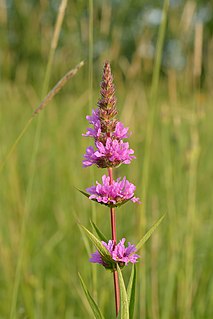
Lythrum salicaria or purple loosestrife is a flowering plant belonging to the family Lythraceae. It should not be confused with other plants sharing the name loosestrife that are members of the family Primulaceae. Other names include spiked loosestrife and purple Lythrum. This herbaceous perennial is native to Europe and Asia, and possibly Australia.
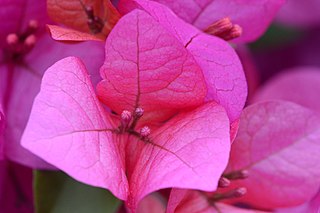
Bougainvillea is a genus of thorny ornamental vines, bushes, and trees belonging to the four o' clock family, Nyctaginaceae. It is native to eastern South America, found from Brazil, west to Peru, and south to southern Argentina. Different authors accept from 4 to 18 species in the genus. The inflorescence consists of large colourful sepal-like bracts which surround three simple waxy flowers, gaining popularity for the plant as an ornamental.

Waratah (Telopea) is an Australian-endemic genus of five species of large shrubs or small trees, native to the southeastern parts of Australia. The best-known species in this genus is Telopea speciosissima, which has bright red flowers and is the NSW state emblem. The Waratah is a member of the family Proteaceae, flowering plants distributed in the Southern Hemisphere. The key diagnostic feature of Proteaceae is the inflorescence, which is often very large, brightly coloured and showy, consisting of many small flowers densely packed into a compact head or spike. Species of waratah boast such inflorescences ranging from 6–15 cm in diameter with a basal ring of coloured bracts. The leaves are spirally arranged, 10–20 cm long and 2–3 cm broad with entire or serrated margins. The name waratah comes from the Eora Aboriginal people, the pre-European inhabitants of the Sydney area.

Euphorbia atropurpurea, called tabaiba majorera or tabaiba roja in Spanish, is a shrub in the family Euphorbiaceae native to Tenerife in the Canary Islands. It can reach 2 metres in height, and grows in ravines, and on slopes and terraces.

Orobanche uniflora, commonly known as one-flowered broomrape, one-flowered cancer root, ghost pipe or broomrape, is an annual parasitic herbaceous plant. It is native to much of North America, where it is a parasitic plant, tapping nutrients from many other species of plants, including those in the families Asteraceae and Saxifragaceae and in the genus Sedum. The name "orobanche" can be translated to "vetch-strangler" and "uniflora" can be translated to "single-flower".

Mimetes cucullatus is an evergreen shrub with several, mostly not branching, upright stems of 1–2 m (3–7 ft) high, that has been assigned to the family Proteaceae. It is the most widespread and most common pagoda species that can cope with a relatively large range of environmental circumstances. It is known under several names including common pagoda in English and rooistompie in Afrikaans.

Hypoestes phyllostachya, the polka dot plant, is a species of flowering plant in the family Acanthaceae, native to South Africa, Madagascar, and south east Asia. The spots often merge into larger areas of colour.
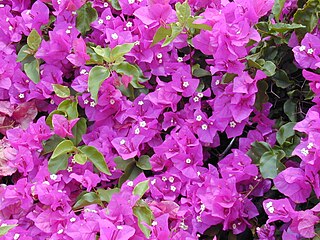
Bougainvillea spectabilis, also known as great bougainvillea, is a species of flowering plant. It is native to Brazil, Bolivia, Peru, and Argentina's Chubut Province.

Trillium kurabayashii is a species of flowering plant in the bunchflower family Melanthiaceae. The species is endemic to the western United States, occurring in extreme southwestern Oregon, northwestern California, and the Sierra Nevada of northern California. It was first described by John Daniel Freeman in 1975. The specific epithet kurabayashii honors Masataka Kurabayashi, a Japanese cytologist and population geneticist who first postulated the taxon’s existence. It is commonly known as the giant purple wakerobin, a reference to its conspicuously large, dark purple-red flower, one of the largest of any sessile-flowered trillium.

Vexatorella alpina, the Kamiesberg vexator, is an evergreen, upright shrub of up to about 1½ m high, in the family Proteaceae. It has entire, long inverted egg-shaped, bluish grey, leathery leaves of 3–4½ cm (1.2–1.8 in) long and 5–13 mm (0.2–0.5 in) wide on a distinct stalk, and globular flower heads of about 2 cm (0.8 in) across at the tip of the branches, and consisting of pale pink flowers with extended, thick-tipped styles. The plants are flowering from September to November. It is an endemic species that is restricted to the Kamiesberge in South Africa.

Vexatorella amoena, also known as the Swartruggens vexator is an evergreen shrub of up to about 1 m (3 ft) high, that is assigned to the family Proteaceae. It has entire, inverted egg-shaped, bluish grey, leathery leaves of 1½–3 cm (0.6–1.2 in) long and 5–11 mm (0.20–0.45 in) wide on a distinct stalk, and globular flower heads of about 2 cm (0.8 in) across with pale pink flowers with extended, thick-tipped styles at the tip of the branches. The plants are flowering from September to November. It is an endemic species that is restricted to the Western Cape province of South Africa.

Mimetes stokoei, the mace pagoda, is an evergreen, upright, hardly branching, large shrub of 1–2 m high in the family Proteaceae. It has silvery, oval leaves of 5–8 cm (2.0–3.2 in) long and 2+1⁄2–4 cm (1.0–1.6 in) wide, with one large tooth supported by two smaller teeth near the tip, at an upward angle and somewhat overlapping each other. The inflorescences are set just below the growing tip, are cylinder-shaped, 10–12 cm (4–5 in) high, topped by a crest of small, more or less horizontal, pinkish-purple tinged leaves. It consists of several flower heads in the axils of golden leaves with a pinkish wash that form a hood shielding the underlying flower head. Each flower head contains eight to twelve individual flowers, with amber-colored styles topped by blackish purple pollen presenters and grey silky perianth lobes. It is endemic to the Fynbos ecoregion of South Africa, being confined to the Kogelberg mountain range. The mace pagoda was twice presumed extinct, but reappeared in its natural habitat from seed, after a wildfire several decades later.

Protea intonsa, also known as the tufted sugarbush, is a flowering plant of the genus Protea within the family Proteaceae, endemic to South Africa, where it is distributed from the eastern Swartberg and Kammanassie Mountains to the Baviaanskloof mountains. In Afrikaans it is known as klossie-suikerbos.

Protea burchellii, also known as Burchell's sugarbush, is a flowering shrub in the genus Protea, which is endemic to the southwestern Cape Region of South Africa.
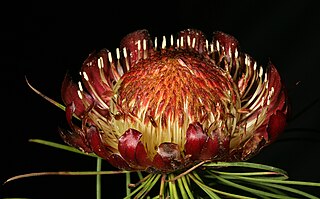
Protea pityphylla, also known as Ceres sugarbush or mountain rose, is a flowering shrub of the genus Protea, in the family Proteaceae. The plant is endemic to the southwestern Cape Region of South Africa.

Protea pruinosa, also known as frosted sugarbush or burnished protea, is a flowering shrub which belongs to the genus Protea within the botanical family Proteaceae. The plant is endemic to the southwestern Cape Region of South Africa.

Protea decurrens, also known as linear-leaf sugarbush, is a shrub of the genus Protea, in the Proteaceae family, which is endemic to the southwestern Cape Region of South Africa. It is a small shrub with a thick underground rootstock, this structure throwing up numerous leafy branches, upon the base of which clusters of flower heads may appear close to the ground. It is pollinated by rodents and grows in low-altitude fynbos or renosterveld.


















